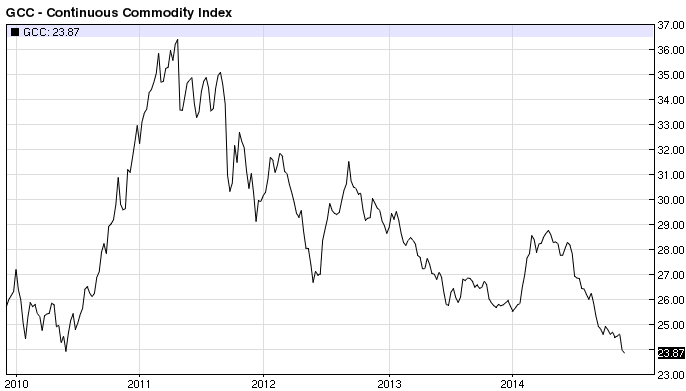The latest U.S. payrolls report presents a challenge for the Fed. As discussed back in April (see post), U.S. labor markets are continuing to heal, suggesting that the rate “normalization” should be a serious consideration for the central bank. However the recent deterioration in commodities, especially energy, is “importing” global disinflation to the U.S. (see post). In particular, the Saudi commitment to retake lost market share has sent shock waves through the oil markets (see post).Â
Â
 |
| GCC is a diversified commodity index (source: barchart) |
As a result, longer-term market-implied inflation expectations have fallen substantially.
Â
Â

Â
The latest declines in expectations came after the recent FOMC minutes already showed increasing concerns at the central bank:Â
FOMC: – “Many participants observed the committee should remain attentive to evidence of a possible downward shift in longer-term inflation expectations.â€
At the same time payrolls in the U.S. are growing at a rate approaching the pre-recession peak (though still materially below what we saw in the 90s).
Â
Â

Â
In fact the divergence between payrolls growth and inflation expectations is currently unusually high. Payrolls are driven by stronger U.S. domestic economy, while inflation expectations are impacted by external factors, which creates this disconnect.
Â
 |
| Red dot represents the current situation |
This mismatch is causing a dissonance for policymakers and market participants, adding to the disagreement on the timing of liftoff. Current market expectations for the first hike now point to Q3 of 2015.
Â
 |
| Source: CME |
However if inflation expectations persist at these levels or worsen, it will be nearly impossible for the Fed to move on rates – irrespective of how much labor markets improve. The bet represented in the chart above is that energy prices will stabilize and/or growth in wages improves substantially by next summer – pushing breakeven expectations higher. But such an outcome, driven to some extent by factors external to the U.S., is far from certain.
What makes the timing of liftoff particularly difficult to estimate is the value of the U.S. dollar.
Â

